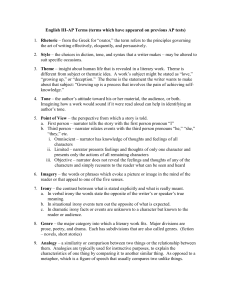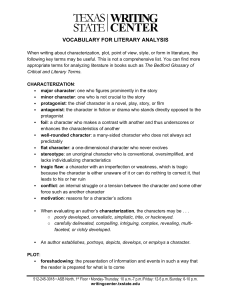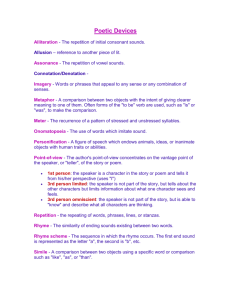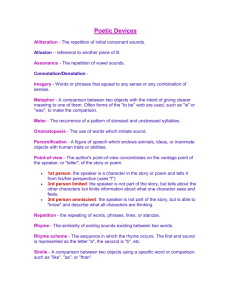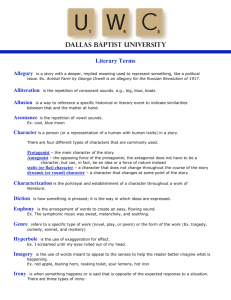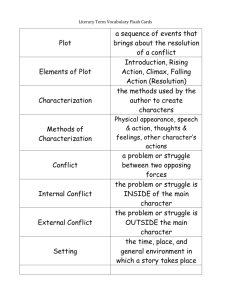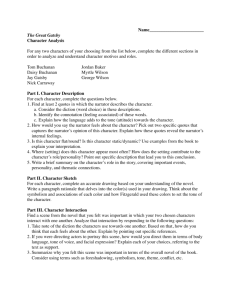AP Literature Exam: Multiple Choice Prep Guide
advertisement
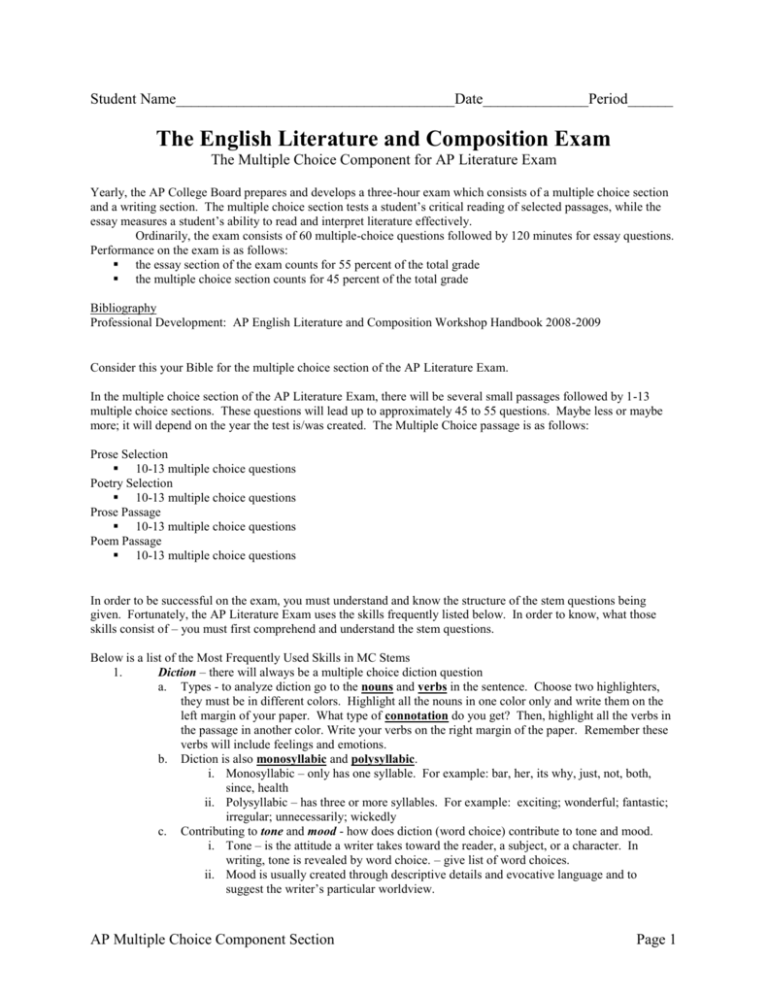
Student Name_____________________________________Date______________Period______ The English Literature and Composition Exam The Multiple Choice Component for AP Literature Exam Yearly, the AP College Board prepares and develops a three-hour exam which consists of a multiple choice section and a writing section. The multiple choice section tests a student’s critical reading of selected passages, while the essay measures a student’s ability to read and interpret literature effectively. Ordinarily, the exam consists of 60 multiple-choice questions followed by 120 minutes for essay questions. Performance on the exam is as follows: the essay section of the exam counts for 55 percent of the total grade the multiple choice section counts for 45 percent of the total grade Bibliography Professional Development: AP English Literature and Composition Workshop Handbook 2008-2009 Consider this your Bible for the multiple choice section of the AP Literature Exam. In the multiple choice section of the AP Literature Exam, there will be several small passages followed by 1-13 multiple choice sections. These questions will lead up to approximately 45 to 55 questions. Maybe less or maybe more; it will depend on the year the test is/was created. The Multiple Choice passage is as follows: Prose Selection 10-13 multiple choice questions Poetry Selection 10-13 multiple choice questions Prose Passage 10-13 multiple choice questions Poem Passage 10-13 multiple choice questions In order to be successful on the exam, you must understand and know the structure of the stem questions being given. Fortunately, the AP Literature Exam uses the skills frequently listed below. In order to know, what those skills consist of – you must first comprehend and understand the stem questions. Below is a list of the Most Frequently Used Skills in MC Stems 1. Diction – there will always be a multiple choice diction question a. Types - to analyze diction go to the nouns and verbs in the sentence. Choose two highlighters, they must be in different colors. Highlight all the nouns in one color only and write them on the left margin of your paper. What type of connotation do you get? Then, highlight all the verbs in the passage in another color. Write your verbs on the right margin of the paper. Remember these verbs will include feelings and emotions. b. Diction is also monosyllabic and polysyllabic. i. Monosyllabic – only has one syllable. For example: bar, her, its why, just, not, both, since, health ii. Polysyllabic – has three or more syllables. For example: exciting; wonderful; fantastic; irregular; unnecessarily; wickedly c. Contributing to tone and mood - how does diction (word choice) contribute to tone and mood. i. Tone – is the attitude a writer takes toward the reader, a subject, or a character. In writing, tone is revealed by word choice. – give list of word choices. ii. Mood is usually created through descriptive details and evocative language and to suggest the writer’s particular worldview. AP Multiple Choice Component Section Page 1 Contributing to Author’s Style – Style is the writer’s characteristic manner of employing language (The AP Vertical Teams Guide for English, p. 16). Tone - If you see a tone question or an identity question you can expect a shift to occur somewhere in the reading passage. a. Identification (the tone) b. In passage as a whole (the tone) c. In one paragraph d. Shifts (in tone) – remember poetry e. Location in shift Inference (Read in between lines to get hints) Vocabulary in Context Syntax – Sentence Structure – this is the function of simple sentences, the writer’s style. Also make sure you know all the terminology to syntax. a. Quotient/verbal patterns b. Phrases, clauses, and sentences Main Idea/Author’s Purpose – this is theme – there are several of these questions Function/Effect of a. Word(s) – how it works in sentence b. Phrases- function c. Clauses d. Literary elements e. Rhetorical strategies – use of detail, repetition Grammar – most grammar will be noun/pronoun reference Figures of Speech/Literary Terms a. Identification b. Finding examples c. Main types used in passages Point of View a. Types i. First Person Point of View – the narrates the story using “I” or “me” to tell the story 1. Participant – The narrator is a central/major character in the story and is directly involved in the action. 2. Major character - The major characters may have prejudices or needs to justify their own actions to themselves which may distort what we're told. 3. Minor character - The minor characters observe the action without being an integral part of it, and they lack essential information. We may have to guess about what really happened or is happening. 4. Innocent Eye Narrator – the character telling the story may be child or a developmentally disabled individual; the narrator is thus naive. The contrast between what the innocent-eye narrator perceives and what the reader understands may produce an ironic effect. 5. Stream of Consciousness - (interior monologue) is a narrative method in modern fiction in which the author tells the story through an unbroken flow of thought and awareness. The technique attempts to capture exactly what is going on in the mind of a character. 6. Different times of a narrator’s life ii. Second Person Point of View - When “you” is used to narrate the story. It can be intimate or accusatory. This should be used in adventure and recipe books. This is a nonparticipant point of view. You will see the use of “you,” “your,” “yourself” but is rarely used in literature. iii. Third Person Point of View 1. Non-Participant Point of View - The nonparticipant point of view is also called the third-person point of view because third-person pronouns (he, him, she, her, they, and them) are used to tell the story. d. 2. 3. 4. 5. 6. 7. 8. 9. 10. AP Multiple Choice Component Section Page 2 “Omniscient” - The all knowing narrator can tell us about the past, present and future of all the characters (godlike). The author enters the minds of all the characters. b. “Limited” - The narration does not use “I” or “me”. Only he/she/it. The narrator focuses on the thoughts and feelings of just one character. The author limits his omniscience to the minds of a few of the characters or to the mind of a single character. Third person limited is similar to omniscient, except the writer can only access the thoughts and feelings of one character. The writer stays by the side of this character, so the story is limited to this one person’s experiences, and the narrator tells the story through this one character’s eyes and mind. By putting limitations on what the reader is able to know, suspense and mystery become much more available to the writer. Also, the narrator often takes on the attitudes of the point of view character, assuming that the character’s beliefs about the events of the story are true. This brings the focus in on this one select character and makes the story much more personal. c. Objective Narrator - The author does not enter a single mind, but instead records what can be seen and heard. This type of narrator is like a camera or a fly on the wall. iv. Psychic Distance (Close 3rd Person) – there are five stages: (1) Basic Situation, General Details, No Emotion; (2) Specific Person, Added Detail, Mild Emotion; (3) Characters are more personal; (4) Extreme Emotion; (5) All Fragments, Particular(ing), Second Person v. Unreliable Narrator - A narrator who, intentionally or unintentionally, relates events in a subjective or distorted manner. The author usually provides some indication early on in such stories that the narrator is not to be completely trusted. To get an understanding of Unreliable Narration the following must be applied: 1. Reconstruct meaning to test validity 2. Too self interested 3. Not sufficiently experienced 4. Not sufficiently knowledgeable 5. Not sufficiently moral 6. Too emotional 7. Actions to inconsistent with words 8. Culturally displaced 9. Compare the facts to the situation 10. Apply your knowledge to the world vi. What If? - What if the point of view changes from a different character’s perspective? What would the outcome of the novel, play or poem be like? b. Multiple – when you see this you need to ask yourself, “What is the effect of multiple points of view?” Typically, Multiple Points of View are present in dramas and plays. Cause and Effect Use of Irony – is the use of contrast a. Types i. Verbal Irony - Consists of implying a meaning different from, and often the complete opposite of, the one that is explicitly stated. Usually, the irony is signaled by clues in the context of the situation or in the style of expression. In complex cases, the detection of irony may depend on values that the author assumes are shared by his or her audience. Be careful, as verbal irony requires subtle reading and comprehension and is always in danger of being misconstrued, and thereby of shocking or offending a naïve audience. (Hamilton 44). ii. Dramatic Irony - Occurs when the audience is privy to knowledge that one or more of the characters lacks. The technique can be used in for comic or tragic effects. iii. Situational Irony - takes place when there is a discrepancy between what is expected to happen, or what would be appropriate to happen, and what really does happen. a. 11. 12. AP Multiple Choice Component Section Page 3 iv. v. vi. vii. viii. ix. x. xi. 13. Typically, both the reader and the characters in the story do not anticipate a surprise or a twist in story line coming. Sarcasm - The taunting use of apparent approval or praise for actual disapproval or dispraise, is mistakenly used as synonymous with verbal irony. The distinctions are that sarcasm is simpler and more crude; in dialogue, it is often signaled by vocal inflection. Pathetic Fallacy - is a type of PERSONIFICATION, in which inanimate aspects of nature, such as the landscape or the weather, are represented as having human qualities or feelings. The term, which was invented by the Victorian critic John Ruskin, derives from the logical absurdity (“fallacy”) of supposing that nature can sympathize with (feel pathos for) human moods and concerns. Typically, pathetic fallacy reflects or foreshadows some aspect of the poem or narrative at that point, such as the plot, theme, or characterization, and so intensifies the tone. Cosmic Irony - Refers to an implied worldview in which characters are led to embrace false hopes of aid or success, only to be defeated by some larger force, such as God or fate. Understatement - Is a form of IRONY in which a point is deliberately expressed as less, in magnitude, value, or importance, that it actually is. Tragic Irony - When dramatic irony occurs in tragedies. Free Verse - Free verse poem's are poem's that do not have rules, they do not rhyme and does not have a meter. The poet makes up the rules for the poem as the poem is progressing or thoughts are being completed. Narrator - A narrator can establish irony based on diction, tone, sarcasm, loose structure in a sentence, shift from one point of view to another, and a string of uncoordinated clauses in a passage (Hamilton 116, 176, 187). Structural Irony - Refers to an implication of alternate or reversed meaning that pervades a work. A major technique for sustaining structural irony is the use of a naïve protagonist or an unreliable narrator who continually interprets events and intentions in ways that the author signals are mistaken. Imagery a. Types i. Visual imagery - something described through sight, appears most commonly in poetry. ii. Auditory imagery - representation of a sound iii. Olfactory imagery - representation of a smell iv. Gustatory imagery - representation of a taste v. Tactile imagery - touch: hardness, softness, wetness, heat, cold vi. Organic imagery - internal sensation, hunger, thirst, fatigue, nausea vii. Kinesthetic imagery - movement, physical tension b. Frame of reference - is a way of looking at the world, whether that's seeing things only in good and bad or immigrant and nonimmigrant terms or it's a matter of thinking that the world operates around meritocracy -- that people earn and then deserve their place in life. For example identifying images using the Holocaust, Asian artwork, Indian music, cowboy setting, summertime vacation. Let’s look at some examples of Multiple Choice questions found on a typical AP exam. Read the questions carefully – identify what each question is based on the component list given by your teacher. Take a look at the exam given in this packet. Remember, there are going to be thirteen skills you will need to know to answer the multiple choice section of the test; this will come from pages 1 and 2 of this packet. AP Multiple Choice Component Section Page 4 The Exam ENGLISH LITERATURE AND COMPOSITION SECTION 1 Time – 1 Hour Directions: This section consists of selections from literary works and questions on their content, form, and style. After reading each passage or poem, choose the best answer to each question and fill in the corresponding oval on the answer sheet. Note: Pay particular attention to the requirement of questions that contain the words NOT, LEAST, or EXCEPT. Questions 1-13. Read the following passage carefully before you choose your answers. Line (5) (10) (15) Mr. Jones, of whose personal accomplishments we have hitherto said very little, was, in reality, one of the handsomest young fellows in the world. His face, besides being the picture of health, had in it the most apparent marks of sweetness and good-nature. These qualities were indeed so characteristical in his countenance, that, while the spirit and sensibility in his eyes, though they must have been perceived by an accurate observer, might have escaped the notice of the less discerning, so strongly was this good-nature painted in his look, that it was remarked by almost every one who saw him. It was, perhaps, as much owing to this as to a very fine complexion that his face had a delicacy in it almost inexpressible, and which might have given him an air rather too effeminate, had it not been joined to a most masculine person and mien: which latter had as much in them of the Hercules as the former had of the Adonis. He was besides active, genteel, gay and good-humoured, and had a flow of animal spirits which enlivened every conversation where he was present. What type of passage is this? PROSE or POETRY Identify what type of skills the following questions are 1. The structure of the sentence beginning in line 5 does which of the following? 2. In context, the word “sensibility” (line 6) is best interpreted to mean 3. The first two paragraphs indicate that the speaker assumes that 4. The shift in the speaker’s rhetorical stance from the first sentence of the second paragraph (lines 11-16) to the second sentence (lines 16-18) can best be described as one form 5. The word “former” in line 15 refers to 6. The speaker’s allusion to Hercules and Adonis (lines 15-16) serves primarily to 7. The use of the phrase “it will be” in line 21 indicates that the speaker 8. The style of the third paragraph differs from that of the first and second paragraphs in that it is 9. In the fourth paragraph, the speaker establishes the predominany tone for the rest of the passage primarily by AP Multiple Choice Component Section Page 5 10. The speaker’s attitude toward “dancing-masters” (lines 50-51) might best be described as 11. The passage indicates that the speaker believes which of the following to be true of Mr. Jones? 12. The final metaphors of the last paragraph (lines 54-57) suggest that this passage most probably precedes a description of 13. The speaker’s tone in the passage can best be described as which of the following? Questions 14-23. Read the following poem carefully before you choose your answers. Sestina Line (5) (10) September rain falls on the house. In the failing light, the old grandmother sits in the kitchen with the child beside the Little Marvel Stove,* reading the jokes from the almanac, laughing and talking to hide her tears. She thinks that her equinoctial tears and the rain that beats on the roof of the house were both foretold by the almanac, but only known to a grandmother. The iron kettle sings on the stove. She cuts some bread and says to the child, What type of passage is this? PROSE or POETRY 14. The mood of the poem is best described as 15. In line 10, “known to” is best interpreted as 16. In line 19, “Birdlike” describes the 17. Between lines 24 and 25 and between lines 32 and 33, there is a shift from 18. The child’s attitude is best described as one of 19. All of the following appear to shed tears or be filled with tears EXCEPT the 20. The grandmother and the child in the poem are portrayed primarily through descriptions of their 21. Throughout the poem, the imagery suggests that 22. Which of the following literary devices most significantly contributes to the unity of the poem? 23. The poet’s attitude toward the characters in the poem is best described as a combination of Be aware that you should spend at least 1 minute and 15 seconds per question answering each question. You will only get 55 minutes to 1 hour for multiple choice exam and 2 hours for three essays. AP Multiple Choice Component Section Page 6


